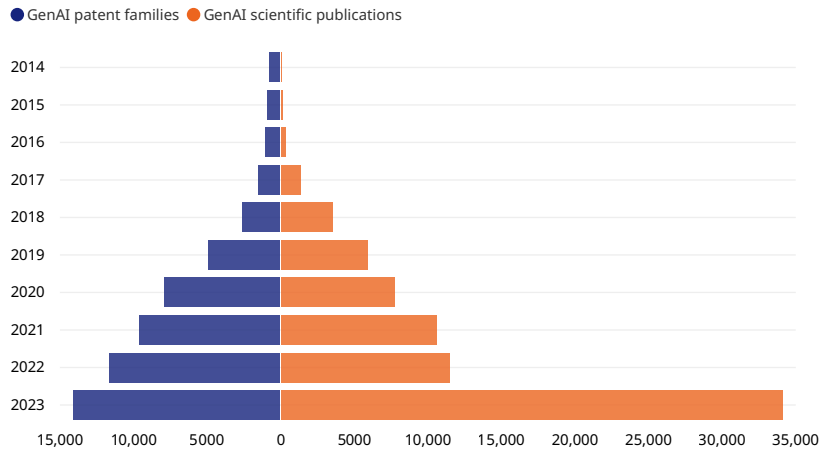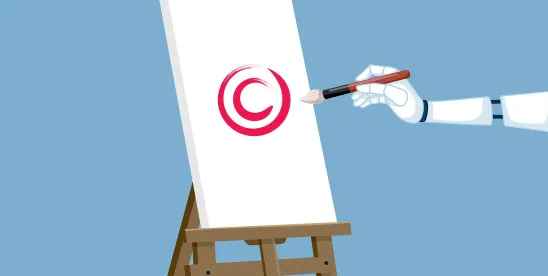As industries increasingly adopt AI to enhance efficiency, innovate products, and solve complex problems, AI solution developers are rushing to secure IP rights in their innovations. Major technology companies, startups, and research institutions are patenting algorithms, machine learning models, and AI applications across fields such as health care, finance, manufacturing, and autonomous systems. This growth in filings reflects not only the expanding scope of AI technologies but also the competitive race to control key innovations.
A particularly steep rise in innovation and patenting has occurred in the field of Generative AI (GenAI), which involves deep-learning models capable of generating high-quality content such as text and images. Examples include AI chatbots like ChatGPT and image generators like DALL-E. The World Intellectual Property Organization (WIPO) 2024 Patent Landscape Report highlights tremendous growth in both scientific publications and patenting activity in the field of GenAI.

WIPO’s report notes that China alone was responsible for more than 38,000 patent families in GenAI between 2014 and 2023, surpassing all other nations combined since 2017. The United States ranks second, with around 6,300 patent families in the same time period. Other top contributors include Korea, Japan, and India. In Europe, the United Kingdom (UK) leads with 714 patents, followed closely by Germany. The Patent Cooperation Treaty (PCT) and the European Patent Convention (EPC) are key routes for GenAI patent filings, with over 7,700 PCT filings and 3,100 EPC filings.
Despite this surge of AI patent filings and grants, varying national legal landscapes pose challenges to AI developers in protecting their technologies in different countries. National patent offices have different patent eligibility requirements and examination standards for AI inventions. As a result, outcomes are jurisdiction specific and may be unpredictable. Patent applicants and their attorneys must carefully navigate these legal variations and adopt strategies that maximize the likelihood of securing patents for AI technologies.
The following is a survey of national patent laws and regulations pertaining to the examination of AI-related patent applications in the most popular patent filing jurisdictions.
United States
The United States remains a global leader in AI innovation. In 2020, the US Patent and Trademark Office (USPTO) reported that 80,000 of utility patent applications involved AI, representing 18% of all utility patent application and in more over 50% of technologies examined. While China leads in total AI patent families in the past decade, US innovations in AI are more widely recognized and protected globally, underscoring the global significance of patenting in the United States. For instance, US companies frequently patent key foundational technologies that have wide-ranging applications, establishing industry standards and propelling significant progress in the development of AI technologies.
In 2024, the USPTO issued new guidance on the subject matter eligibility for AI inventions. The guidance explains how the current two-step Alice/Mayo test applies to AI inventions, while the examples show how different types of AI-related claims are analyzed for patent eligibility under this standard. The main takeaway is that AI inventions are more likely to be deemed subject matter eligible when the claims describe specific technical improvements, hardware implementations, provide specific details about the training and/or implementation of the AI model, and show the incorporation of the AI models into an improved technological process. A more detailed analysis of the 2024 USPTO guidance and our recommendations for drafting of AI-related patent applications are described in our recent publication here.
China
China has outpaced the United States in AI patent filings since 2021. In 2023 alone, China granted more than twice as many AI patents as the United States, highlighting its growing dominance in this technological area. This surge is part of China’s national strategy to lead in AI by 2030, driven by significant investments in AI research and development. China’s more lenient patent examination guidelines have contributed to its dominance in AI-related patent filings and grants, particularly in the fields of GenAI and deep learning. China’s 2023 updated Guidelines for Patent Examination allow patents for AI algorithms that solve technical problems or improve computer system performance, helping the country account for 61.1% of the world’s granted AI patents.
Japan
Despite an overall decline in patent applications, Japan has seen a steady increase in AI-related filings since 2014. AI inventions have a high patent grant rate of around 80%, and Japan’s guidelines permit AI-related patents as long as they clearly qualify as a “program.” However, applicants should avoid explicitly referencing “neural network” or “model” in titles, as these are frequently rejected. Instead, claims should focus on “information processing using a neural network/model” or highlight novel AI configurations (e.g., RNN, CNN). Patents for AI methods or services are also possible if the novelty lies in the method itself, rather than the AI model. Novelty assessments follow the same standards as traditional information processing inventions.
European Union
Europe remains a key player in AI patenting. The European Patent Office (EPO) is working to harmonize AI patent examination practices across member states, resulting in a steady increase in patent filings. However, the EPO applies stringent requirements under the EPC, requiring AI inventions to demonstrate technical character and solve a specific technical problem. The new EPO guidelines require that the mathematical methods and training data used by an AI invention should be disclosed in sufficient detail to reproduce the technical effect of the invention over the whole scope of the claims. Leading contributors to Europe’s AI patent portfolio include the UK and Germany.
Conclusion
The race to patent AI technologies is not only intensifying, but shaping the future of innovation. To protect their inventions, companies and inventors must navigate difficult legal frameworks across the globe. While patenting AI requires careful strategic planning, the sharp rise in filings and grants show that it is not only possible to patent AI inventions but essential. Understanding the specific patent eligibility requirements of various jurisdictions, developing a global patent portfolio strategy, and adopting the correct drafting and prosecution strategies will be critical to maximize the chances of obtaining a patent for AI technologies.




 />i
/>i
